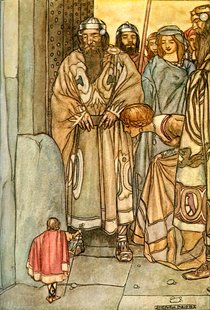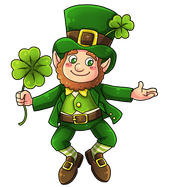|
There's a story about a tiny man who comes to the king's court. The man is so tiny that when he looks into a pot of porridge, he slips, falls in, and almost drowns. Sounds like Tom Thumb, right? Let's go back a little ways to an Irish tale - the Saga of Fergus mac Léti. This appears in the Senchas Már and its Old Irish glossings. The Senchas Már is a compilation of early Irish law texts from the 7th and 8th centuries. The brief poem about Fergus has to do with the restitution made after the murder of a slave, and mentions Fergus' own death by drowning. The Irish glossings of the 8th century (MSS TCD H.3.18 and Harlean 432) go into more depth. Some water-sprites (known as the "lúchorpáin," or "little bodies") try to drag the sleeping King Fergus into the sea. He wakes up and catches them. In exchange for their freedom, they give him three wishes, including the ability to breathe underwater. However, they tell him never to swim in Loch Rudraige (or Lockrury). One day he disobeys them and finds a sea monster there called Muirdris, which leaves him with a disfigured face. His court attempts to hide this, but the truth eventually comes out when a slave woman named Dorn tells him the truth. In his fury, Fergus kills her, then returns to the loch, where he and the monster both die in a battle that leaves the loch red with blood. Many scholars believe that this story of the lúchorpáin is the first mention of leprechauns. Flash forward to the Irish manuscript known as Egerton 1782. This was written in 1517-1518 by the scribes of the O'Mulconry family and includes over sixty tales, poems, and miscellania. Among the tales is an expanded version of the death of Fergus mac Leti. This is a longer, more comical and sexual version that names the rulers of the Lupra and Lupracan: King Iubdan (pronounced Uf-don) and Queen Bebo (Bay-voe).
One day, Iubdan holds a banquet. Bebo sits at his side. All his strongest warriors are there, including a great strongman who's mighty enough to chop down a thistle at one stroke. The ale flows, people make merry, and finally Iubdan stands up and begins to shout, "Have you ever seen a king greater than myself?" No, no, he's the greatest king, he has the mightiest warriors, the finest army the world has ever known. But suddenly, the king's chief poet Esirt bursts out laughing. An incensed Iubdan is all set to have him arrested, but Esirt tells him of the land of Emania, where the people are like giants to them. Iubdan's mighty army is worth peanuts by comparison. Esirt goes there to prove that he's right, and the people there are astonished by the "dwarf that could stand on full-sized men's hand." They carry him in to Fergus' banquet table. Esirt refuses to accept any food or drink, so Fergus plops him into his goblet, where Esirt floats around and almost drowns. They make amends, though, and at the end of three days, Esirt goes home along with Fergus' poet Aedh. Although Aedh is the king's dwarf, he still seems a giant to the Lupra people. Now Iubdan and Bebo set off. They want to visit the palace and try the porridge (which Esirt has mentioned) before dawn, so no one will see them. But they can't reach the top of the cauldron. Iubdan has to stand on his horse, finally gets over the edge, only to fall into the porridge and be trapped. Much drama ensues, with husband and wife wailing and singing poetically to each other, until morning comes and people find them. They're taken to Fergus and remain his prisoners for a full year, until finally the Lupra-folk send an army to find them and offer a ransom. But Fergus will accept none of their offers, until Iubhdan gives him his greatest treasure in return for his freedom. This is a pair of shoes which allow a man to walk freely underwater. However, once again, Fergus swims in Lockrury and seals his own fate. This story is recorded around 1517 - a century before the first existing copy of Tom Thumb in 1621, where Tom falls into a pudding and later makes his way to the court of King Arthur. In a later, expanded version around 1700, Tom twice goes to Fairyland and twice returns. The first time, he announces his arrival at court by plummeting into a bowl of frumenty - a dish of boiled, cracked wheat. Basically, porridge. (The second time, he has an encounter with a chamber pot, but let's not talk about that.) In my opinion, there are two unique elements that typically characterize Thumbling tales. The story of Iubhdan and Bebo has both. One is the focus on a character's incredibly small size. The other is the swallow cycle. In the swallow cycle, the character is swallowed by animals and gets out - often multiple times. Tom Thumb travels through a cow's digestive system; is gulped up a giant and spit out; is eaten by a fish and escapes when the fish is caught and cut open. In the Brothers Grimm, there are two Thumbling tales; the heroes are swallowed by cows, foxes and wolves. In one case, the tiny boy yells and complains from inside the cow's belly while it's being milked. In Japan, an oni tries to eat Issun-Boshi, only for the tiny samurai to come out fighting. As you go through Thumbling stories from different cultures, you'll find heroes again and again who are swallowed by cattle, lions, or other animals, and manage to get out one way or another. It's not unlike the Biblical tale of Jonah and the whale. Why exactly does this appeal to humans across so many countries and so much time? “The Catalan Versions of AaTh 700: a Metaphor of Childbirth," an article by Carme Oriole, suggests that the swallow cycle represents pregnancy and childbirth, particularly the way a young child would see it. (A toddler might hear "The baby is in Mommy's tummy" and think Mommy had eaten the baby.) This is particularly apt because most (but not all) thumbling stories begin with the hero's unusual conception and birth. Sometimes the conception is caused by the mother eating a fruit or seed. But it's not just swallowing, it's immersion. Tom Thumb is immersed in a pudding and must break his way out. Similarly, the Grimms' Daumerling is cooked into a sausage. For the Italian Cecino, immersion means falling into a puddle - and death by drowning. For Tommeliten or Tume in Norwegian tales, falling into a bowl of buttered porridge also means death by drowning. Carme Oriole may be right. For the Japanese Mamesuke and the Norse Doll i' the Grass, immersion means falling into a bathtub or a river - and then rebirth. They become human-sized and begin life with their new spouse. In the expanded Tom Thumb, Tom nearly dies, and symbolically is reborn. He returns to the human world each time while being immersed in liquid (like porridge) and reemerging. In most cases the immersion scene is meant as comedy. I don't think the storytellers put much thought into ideas of rebirth. Just "The little man is SO tiny, he falls into some soup and thinks he's drowning!" And the story of Fergus mac Leti manages to fit in two immersions - one in liquor, one in porridge. Although Iubdan and Bebo are little-known today, some writers have suggested that their story inspired Gulliver's Travels, and the scenes in Lilliput and Brobdingnag. (For instance, in the land of the giants, Gulliver is dropped into a bowl of cream and nearly drowns.) I think it's possible they influenced Tom Thumb as well. Resources
Text copyright © Writing in Margins, All Rights Reserved
0 Comments
Leave a Reply. |
About
Researching folktales and fairies, with a focus on common tale types. Archives
July 2024
Categories
All
|
Writing in Margins


 RSS Feed
RSS Feed
